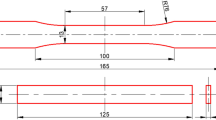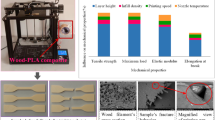Abstract
This paper aims to investigate the mechanical properties of specimens printed by 3D open-source printers. It discusses the effect of five factors (part orientation, layer height, extrusion width, nozzle diameter, and filament temperature) on the ultimate tensile strength and the impact toughness of the 3D-printed samples. A 25–1 resolution V fractional factorial experiment was run with the 16 samples printed on a Prusa I3 MK3S in PLA. Tensile strength and impact toughness were tested using Instron 3367 and Tinius Olsen 66 testers, respectively. In analyzing the data, a normal probability plot of the effects complimented with ANOVA (Analysis Of Variance) revealed that, for both responses, only part orientation was statistically significant at p = 0.05. Regression equations were used to predict the ultimate tensile strength and the impact toughness as a function of the part orientation. Both the toughness response and the tensile strength response are maximized with horizontal part orientation. Verification experiments have been implemented to validate the adopted regression equations’ predictions under different circumstances, and the results of those experiments appear to confirm the model.













Similar content being viewed by others
Availability of data and material
The data that support the findings of this study are available in Table 2.
Code availability
Not applicable.
References
Bikas H, Stavropoulos P, Chryssolouris G (2016) Additive manufacturing methods and modelling approaches: a critical review. The International Journal of Advanced Manufacturing Technology 83(1–4):389–405
Lipton JI, Cutler M, Nigl F, Cohen D, Lipson H (2015) Additive manufacturing for the food industry. Trend Food Sci Technol 43(1):114–123
Tan HW, An J, Chua CK, Tran T (2019) Metallic nanoparticle inks for 3d printing of electronics. Adv Electro Mater 5(5):1800831
Murr LE (2016) Frontiers of 3d printing/additive manufacturing: from human organs to aircraft fabrication. J Mater Sci Technol 32(10):987–995
Talagani M, DorMohammadi S, Dutton R, Godines C, Baid H, Abdi F, Kunc V, Compton B, Simunovic S, Duty C et al (2015) Numerical simulation of big area additive manufacturing (3d printing) of a full size car. SAMPE J 51(4):27–36
Pivsa-Art W, Chaiyasat A, Pivsa-Art S, Yamane H, Ohara H (2013) Preparation of polymer blends between poly (lactic acid) and poly (butylene adipate-co-terephthalate) and biodegradable polymers as compatibilizers. Energy Procedia 34:549–554
Wu J (2018) Chapter 5 - material interface of pantograph and contact line. In: Wu J (ed) pantograph and contact line system, high-speed railway. Acad Press pp 165–191. https://doi.org/10.1016/B978-0-12-812886-2.00005-7, https://www.sciencedirect.com/science/article/pii/B9780128128862000057
Davis JR (2004) Tensile testing. ASM International
Wang L, Gardner DJ (2017) Effect of fused layer modeling (flm) processing parameters on impact strength of cellular polypropylene. Polymer 113:74–80
Tymrak B, Kreiger M, Pearce JM (2014) Mechanical properties of components fabricated with open-source 3-d printers under realistic environmental con- ditions. Mater Des 58:242–246
Bledzki AK, Jaszkiewicz A, Scherzer D (2009) Mechanical properties of pla composites with man-made cellulose and abaca fibres. Compos A Appl Sci Manuf 40(4):404–412
Tanikella NG, Wittbrodt B, Pearce JM (2017) Tensile strength of commercial polymer materials for fused filament fabrication 3d printing. Addit Manuf 15:40–47
Liu X, Zhang M, Li S, Si L, Peng J, Hu Y (2017) Mechanical property parametric appraisal of fused deposition modeling parts based on the gray taguchi method. Int J Adv Manufact Technol 89(5):2387–2397
Cantrell JT, Rohde S, Damiani D, Gurnani R, DiSandro L, Anton J, Young A, Jerez A, Steinbach D, Kroese C et al (2017) Experimental characterization of the mechanical properties of 3d-printed abs and polycarbonate parts. Rapid Prototyp J
Durgun I, Ertan R (2014) Experimental investigation of fdm process for im- provement of mechanical properties and production cost. Rapid Prototyp J
Pei E, Lanzotti A, Grasso M, Staiano G, Martorelli M (2015) The impact of process parameters on mechanical properties of parts fabricated in pla with an open-source 3-d printer. Rapid Prototyp J
Zaldivar R, Witkin D, McLouth T, Patel D, Schmitt K, Nokes J (2017) Influence of processing and orientation print effects on the mechanical and thermal behavior of 3d-printed ultem® 9085 material. Addit Manuf 13:71–80
Gunst RF, Mason RL (2009) Fractional factorial design. Wiley Interdiscip Rev: Comput Stat 1(2):234–244
Montgomery DC (2017) Design and analysis of experiments. John wiley & sons
Author information
Authors and Affiliations
Corresponding author
Ethics declarations
Ethics approval
Not applicable.
Consent to participate
Not applicable.
Consent for publication
Not applicable.
Conflict of interest
The authors declare no competing interests.
Additional information
Publisher's Note
Springer Nature remains neutral with regard to jurisdictional claims in published maps and institutional affiliations.
Rights and permissions
About this article
Cite this article
Mazen, A., McClanahan, B. & Weaver, J.M. Factors affecting ultimate tensile strength and impact toughness of 3D printed parts using fractional factorial design. Int J Adv Manuf Technol 119, 2639–2651 (2022). https://doi.org/10.1007/s00170-021-08433-0
Received:
Accepted:
Published:
Issue Date:
DOI: https://doi.org/10.1007/s00170-021-08433-0




